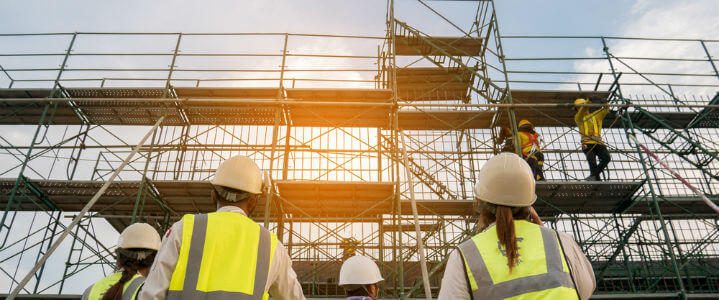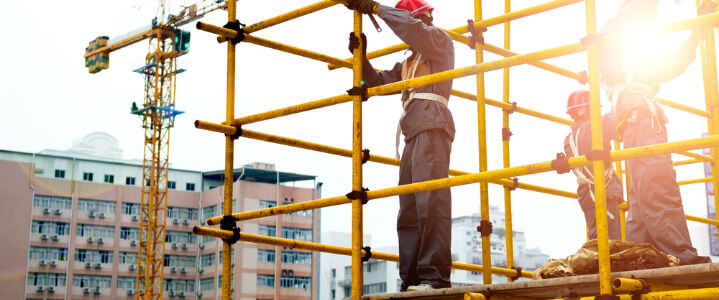Construction workers often work at heights and face a variety of risks. To ensure their safety, OSHA has established specific scaffolding requirements. These rules are designed to protect workers from falls, injuries, and other hazardous conditions while working on scaffolds. After all, improper scaffolding is the #3 most cited OSHA violation. This article will discuss the OSHA requirements for scaffolding in construction sites and how they can help keep workers safe.
Below, you’ll find 12 scaffolding safety rules and some other helpful information.
12 OSHA Scaffolding Standards & Safety Requirements
Every year, around 4,500 workers suffer scaffolding injuries. Approximately 50 of those workers die as a result. For your convenience, we have provided you with an outline of the OSHA scaffolding requirements below. As always, refer to the official OSHA documentation for more details and information.

1. Weight Capacity
How much weight must a scaffold be capable of supporting?
Your scaffold must be structurally sound and sturdy enough to support its weight plus four times the maximum intended load. It should do all of this without settling or any displacement whatsoever. Supported scaffolds should be set up on completely solid footing. Following these fall protection safety tips can help keep your workers safe and your business compliant.
2. Stability
Unsteady objects, such as loose bricks, boxes, barrels, or other makeshift supports, should never be used to support planks or scaffold platforms. This can lead to dangerous shifts in the working platform, increasing the risk of falls. Always use OSHA-compliant scaffold components designed for load-bearing support.
3. Supervised Setup
A qualified person must supervise workers as scaffolds are erected, dismantled, moved, or altered in any way. This ensures that the scaffold assembly follows OSHA standards and that all safety measures, including scaffold fall protection and personal fall arrest systems, are properly in place before work begins.
4. Extra Precaution
All scaffolding must be equipped with toeboards, midrails, and guardrails. Wondering about scaffold guardrail height requirements? Here are the scaffold guardrail requirements.
The toprails manufactured and in service after January 1, 2000, must be between 38 and 45 inches tall. For toprails manufactured and in service before January 1, 2000, the height must be between 36 and 45 inches.
5. Maintenance
Brackets, braces, screw legs, trusses, and ladders should be routinely examined. Any weak or damaged equipment should be repaired or replaced immediately. The integrity of scaffold components is critical in preventing failures that could lead to worker injuries or fatalities.
6. Materials
Your scaffold platforms should be tightly planked, and the correct scaffold plank grade material or an equivalent should always be used. Loose or improperly fitted planks can create tripping hazards or allow tools and materials to fall from the platform, putting workers below at risk.
7. Scaffolding Inspection
The designated and certified “competent person” is required to inspect all scaffolding. This qualified person must re-inspect at predetermined intervals. Even the slightest alterations/shifts could pose a potential danger to workers.
8. Rigging Inspection
The rigging on all suspended scaffolds must undergo inspection by a competent person before each shift. If any part of the rigging is damaged or loose, the scaffold’s stability could be compromised. Connections must be tight, and all scaffold components should be free of visible damage. Adjustable suspension scaffolds, in particular, should be checked to ensure proper weight distribution and secure attachment points.
9. Rigging Protection
Natural or synthetic rope involved in the suspension scaffold setup should be monitored. It needs to be protected from nearby heat-producing machinery and other sources.
10. Diagonal Braces Instruction
Employees must be trained on the hazards of using diagonal braces as fall protection. OSHA standards require the use of proper fall arrest systems, such as a personal fall arrest system, to prevent falls. Workers should never rely on diagonal braces as a substitute for scaffold fall protection.
11. Access
Safe access to scaffolding is required. Workers should only use designated stairwells or ladders to reach the working platform. Climbing on cross braces or using unstable objects to gain access increases the risk of falls and should never be allowed.
12. Power Line Distance
Your scaffolding must always rest at least 10 feet away from electrical power lines. Coming into contact with live wires can result in electrocution, posing a life-threatening hazard. Always assess the job site for electrical risks before setting up any scaffold system.

Feeling overwhelmed? A safety consulting firm like Safety by Design can save you time and energy. Our training will equip you and your employees with scaffolding safety and so much more.
How High Can You Build a Scaffold Without a License?
The OSHA scaffolding safety procedures guide says it like this. Employers must provide fall protection for every employee on scaffolding more than 10 feet above a lower level. A competent person should determine the fall protection for employees working on supported scaffolds.
Learn more about our OSHA Scaffold Competent Person Training today!
Following construction scaffolding safety protocols is 100% necessary. OSHA states that scaffolds more than 125 feet in height above the base must be designed by a registered professional engineer. These scaffold height restrictions reflect the hazards and structural stress when working at such heights.
In addition, scaffolding harness regulations should be determined by your competent person. Personal fall arrest systems involve the harnesses themselves, but they also involve the components of these belts like Dee-rings, lifelines, snap hooks, and the anchorage point.
Finding the Best OSHA Scaffold Training Company Near You
Interested in OSHA scaffold training? We can help you comply with all the OSHA and ANSI scaffold standards. Use Safety by Design’s safety training in Houston to ensure a secure workplace.
Have questions concerning scaffolding laws, regulations, and everything in between? We’ll go above and beyond to answer them and make your company safer! Whatever your workplace training needs, contact the Safety by Design team today.
Thank you for visiting our website! We appreciate your interest in workplace safety. Please note that Safety by Design is not affiliated with OSHA. However, we can assist you with the following OSHA-related services:
- OSHA Mock Inspection
- OSHA Training
- Facilitate OSHA Inspections and Citations
If you need to file a complaint with OSHA, please call 800-321-6742 (OSHA) or visit this page for other methods to contact them.




